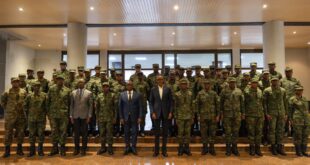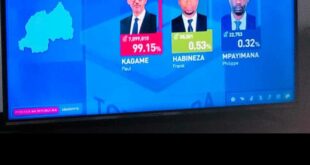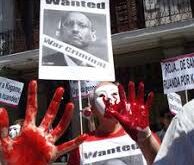By: New Vision
Fred Gisa Rwigyema was shot in the head in Nyabwenshogozi Hill on October 2, 1990, on the second day of the struggle he led to liberate Rwanda, commanding a group of 1000 men, a splinter of NRA, now the popular UPDF.
The official narrative from Kigali had until recently been that Rwigema was killed by a stray bullet which was even documented in history books.
But over the years, some other versions about Rwigyema’s death emerged but with no evidence as the interviewers quoted anonymous sources.
The stray bullet account therefore, remained the official line not until a former RPF commander and a childhood friend of Rwigema spilled the secrets of Rwigyema’s last moments in the jungles of Matimba Hill between 8am and 10 am on 2ndOctober 1990.
Speaking to this website, Maj. Michael Mupende says he lives in U.S.A with his family where he sought exile in the last 19 years after surviving assassination three times while serving Rwanda President Paul Kagame’s regime.
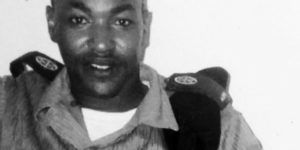
Just like Rwigyema, Mupende participated in the NRA struggle of 1980s that ushered the NRM government in power before moving to liberate Rwanda in 1990.
“My Names are Michael Mupende, I was born in the 60’s to Heziron Kayumba and Penina Nzakamwita. I was born years shortly after my family and other Tutsi refugees were fleeing to Uganda following the outbreak of the Rwandan Conflict (1959- 1963) in which my people were targeted by fellow citizens- the Hutus,” he said, adding that his place of birth is Kabezi parish, Ngoma sub-county, Kajara county formerly Ankole district.
His parents would later relocate to Nshungerezi refugee camp in Kikagate, Isingiro and its here that Mupende started school at Kajaho primary school, then Kololo SS in Kampala and later APAS, a business institute.
He extended his education while in exile at Baltimore city community College and later at the University of Baltimore.
While living in a refugee camp in Isingiro, Mupende heard of the famous Emmanuel Gisa family which had a charismatic, selfless and fervent young man- Fred Rwigyema.
“My elder siblings kept talking about this boy they used to play with before his family moved to Tooro while other refugee went to Bunyororo in a process of relocation,” he said.
As some Rwandan refugees returned home 80s, Mupende’s family remained in Uganda, he stayed in Kampala with some of his siblings and was later introduced to Fred Rwigyema who also stayed in the same city.
“In 1980 I met Rwigyema a couple of times in Kampala areas of Bugolobi and Makindye, this time through my late brother and my sister, and later through other Banyarwanda acquaintances.”
He adds that, “In late 1980 Rwigema and my brother Emmanuel Butera alias Byaruhanga were dropped from UNLA and I was seeing him frequently and so when I joined NRA we were not strangers, Rwigyema’s high ranking position did not actually matter in as far as relating to the people he knew, he was very interpersonal and humorous.”
In a nutshell, Mupende describes Rwigyema as brave, charismatic and a loving selfless leader who showed great love and care to those under his leadership and inspired devotion into them with courage.
“Fred was ready to face and endure any danger if he felt a justified cause, he was more concerned with the needs and wishes of others than his own. There are many evidences to testify Fred’s personality for those who worked or lived around him in NRA”
Rwigyema’s Death. How it Occurred
Mupende expounds on the events of October 2, 1990 from 0500 hrs, the second day of the Rwanda invasion under the command Rwigema before he got killed.
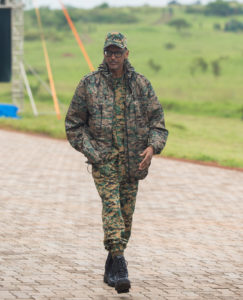
“It was at approximately 0530 hrs Rwandan time. Rwanda Armed Forces that had done their air reconnaissance the previous afternoon, started shelling our defensive area at Kagitumba border post and the surroundings using 120mm mortars at Nyabweshongezi junction,” recalls Mupende.
After an hour of non-stop action, fighting ceased and resumed at 7am with the enemy raiding the rebel positions under the command of Sam Byaruhanga who commanded the first battalion and sixth battalion led by Charles Ngoga who were on the right side of Matimba hill.
Meanwhile Mupende commanded the fourth battalion. The rebels managed to overpower the enemy (Rwanda Forces) and were repulsed forcing them to withdraw.
The heavy gunfire according to Mupende lasted for approximately 30 minutes.
“From my position to the left of the Kagitumba -Kigali southbound road, I saw from the corner on the tarmac emerging two reconnaissance armored vehicles on slow movement approaching our positions, I alerted other commanders, Ngoga and Bagire. The vehicle was attacked with 75mm launchers and its occupants jumped out and took off,” he narrates.
From 8:30am there was calmness but only sporadic shooting could be heard from afar, this prompted Fred Rwigyema and his platoon moved around through the tarmac from Kagitumba towards the main battalions that laid ambush in the tall grass on the slopes of Matimba hill.
“Rwigyema was listening to the BBC news not far from where I was standing and I could hear it from my position. Upon reaching my defence line, Fred and soldiers switched to the right and ascended Matimba Hill,” Mupende remembers.
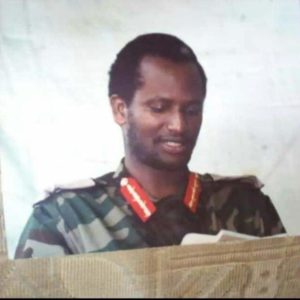
Major Mupende insists that while Rwigyema and group ascended to the top of the hill, no single shot was heard or fired by the enemy force in retaliation. It is only the rebels that fired bullets to clear their front.
At around 1020 hrs, the soldiers that had been moving with Rwigyema could be seen gathering quickly and attending to an emergency which prompted seniors who led different battalions to intervene and amongst them was Mupende.
He then reached out to a teary bodyguard of Rwigyema known as Lt. Katongole who announced to him that Rwigema had been shot dead.
“Afande afude, afude…!!” a Luganda statement meaning the commander is dead.
The news was delivered to doctors at the border post who rushed to the scene in a 110 white Landrover vehicle.
Controversy
Mupende says that as Rwigyema’s body has been carried to the awaiting Landrover, he physically assessed the wounds, he found out that bullet had shattered his neck, moving through the throat and up to the chin.
But what ignited a protracted disagreement was that the bullet entry point was at the back of Rwigyema’s neck.
This means that either the enemy who shot him emerged from behind or he had been shot by someone from his team.
Mupende also remembered that while combing the enemies’ territory no single shot had been fired from the opposite side.
“All the officers that were present saw exactly what I saw that day, there was nothing hidden,” he said.
Mupende later moved to the border customs building for briefing. He still assessed Rwigyema’s body, this time it had been cleaned, the findings were not different from the what he saw earlier.
Mupende regrets that from his earlier position he could not be able to see who shot his commander. But after subjecting Rwigyema’s bodyguards to interrogations, they said they had identified the suspect amongst themselves.
“It was an officer who had been entrusted to carry the sniper silenced rifle that Fred always possessed within his security, the rifle is currently owned and under care of the close top guards of the current president of the Republic of Rwanda,” Mupende alleges.
Our efforts to get a comment from Kigali were unsuccessful as no official was willing to comment on this matter.
In Part 2 of this story will bring you Mupende’s ordeal after he became vocal of Rwigema’s death and how he beat the 24 surveillance to survive alleged assassination attempts and escaping to Uganda in 2001.
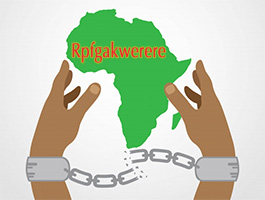 Africa Just another WordPress site
Africa Just another WordPress site
